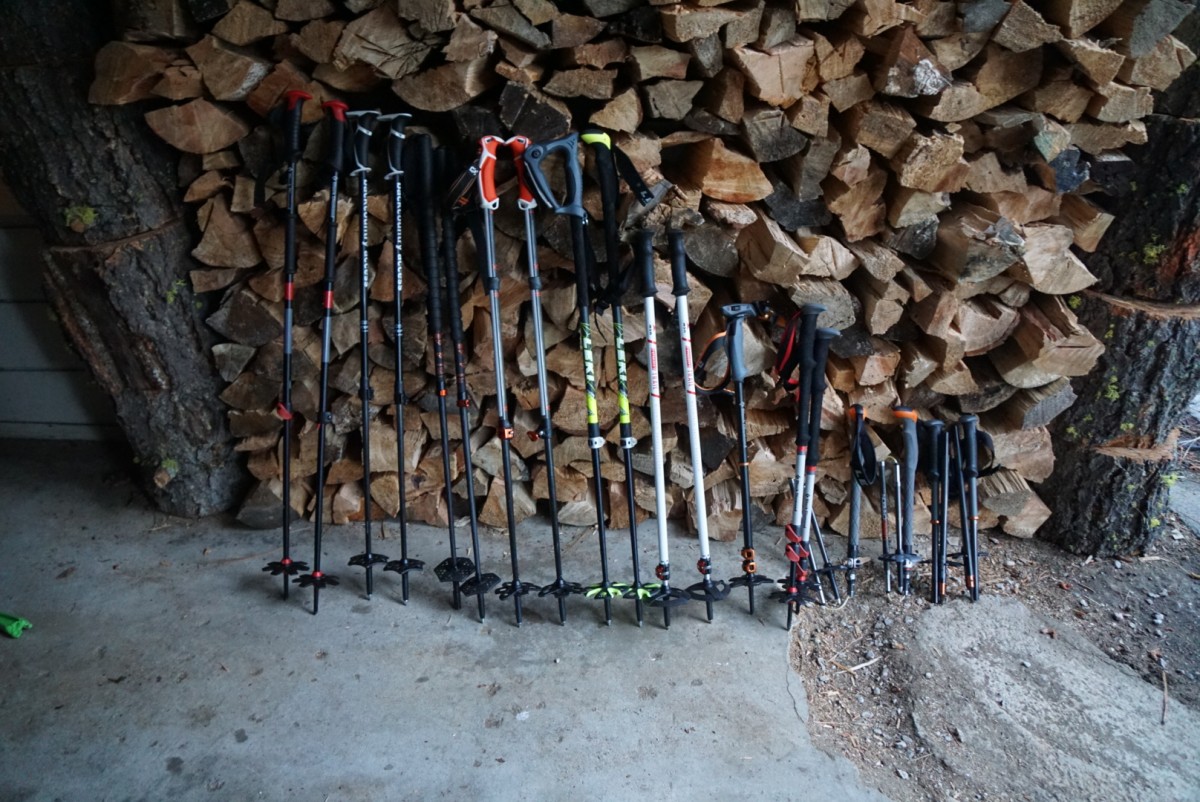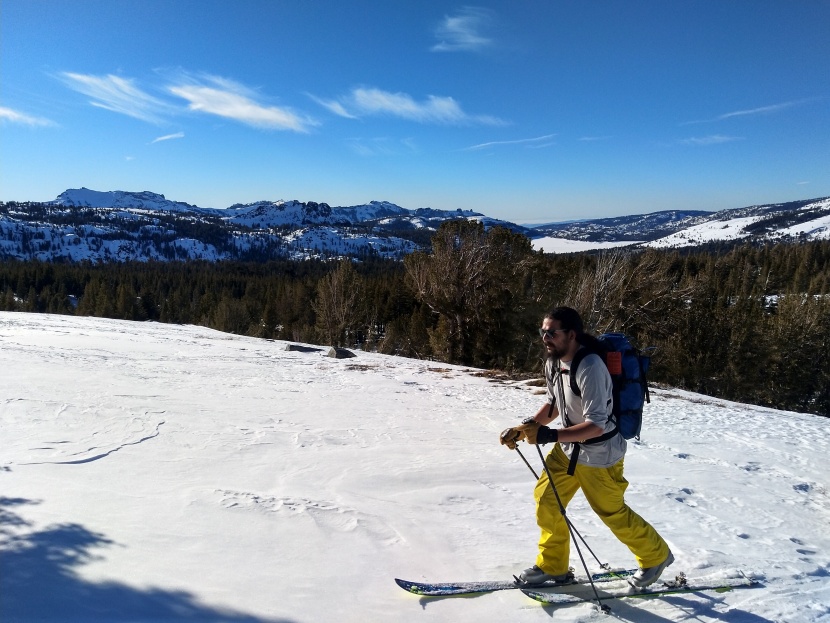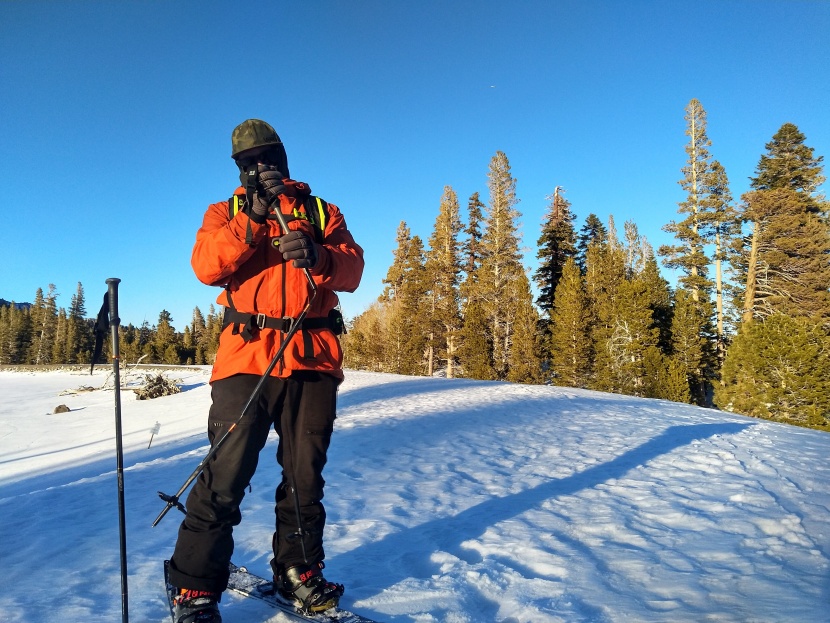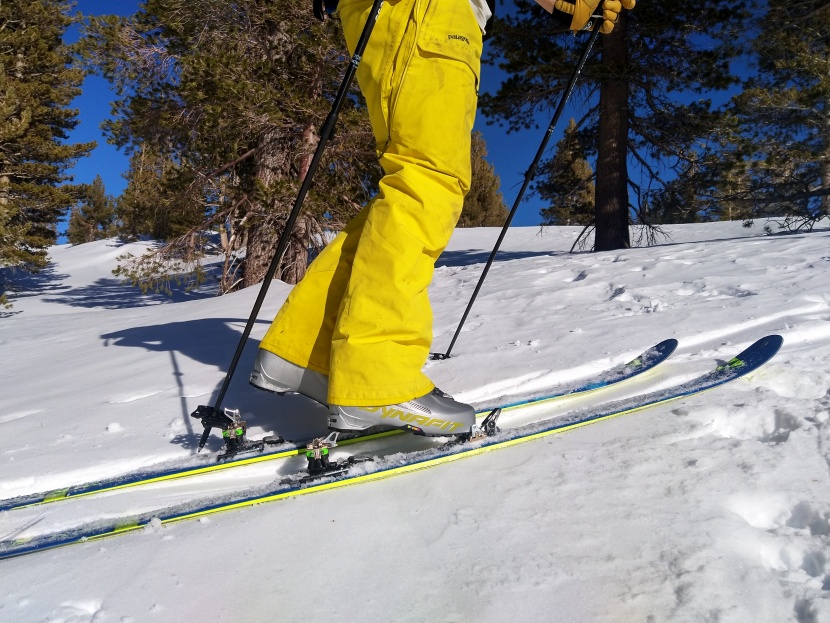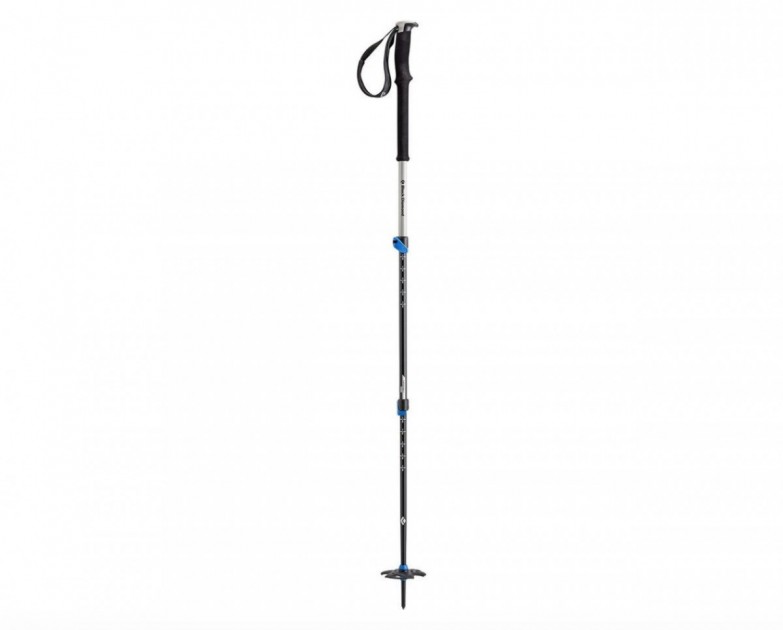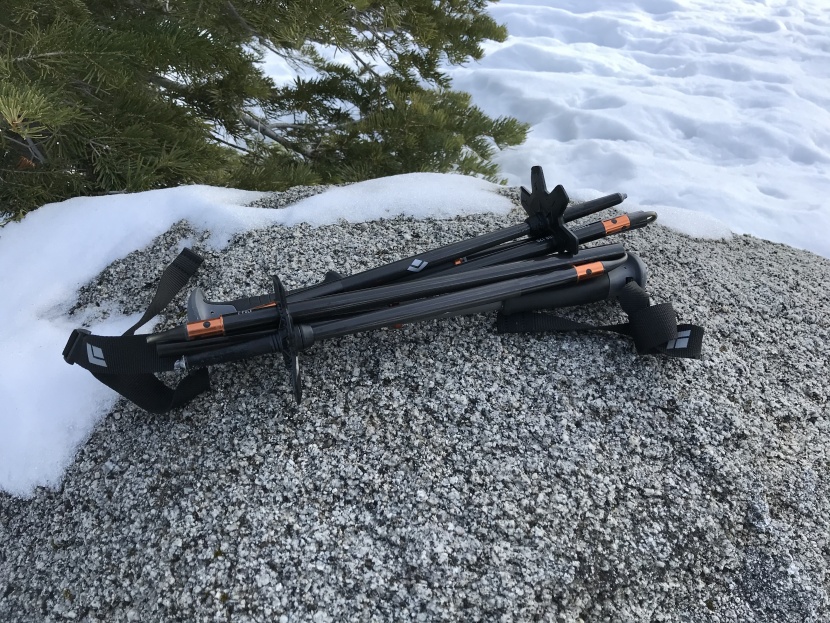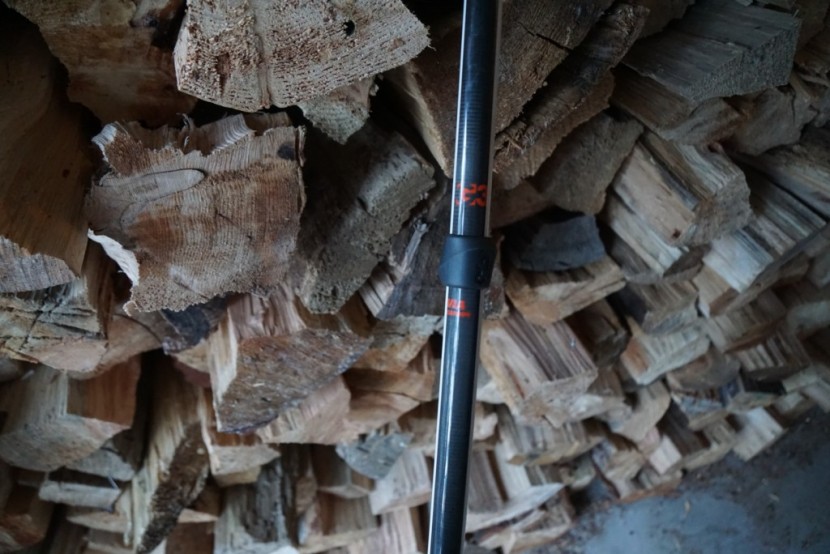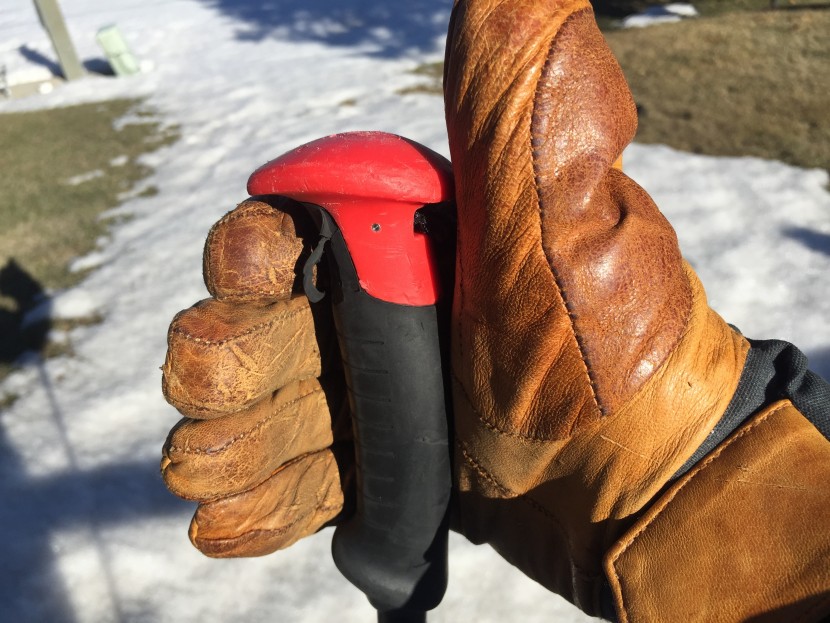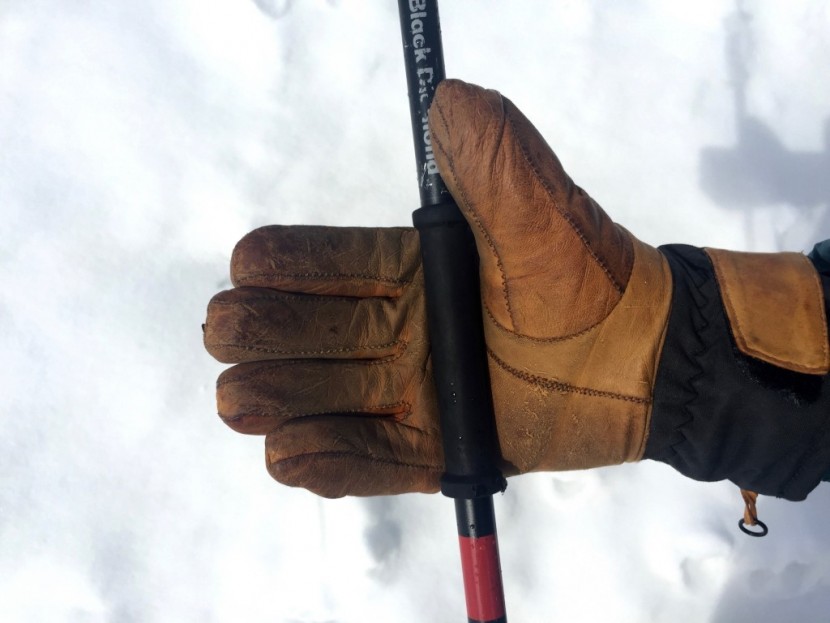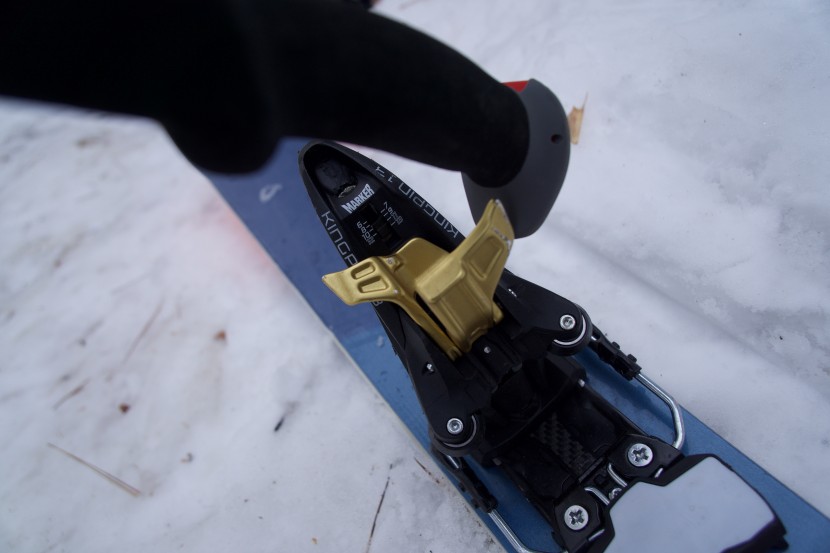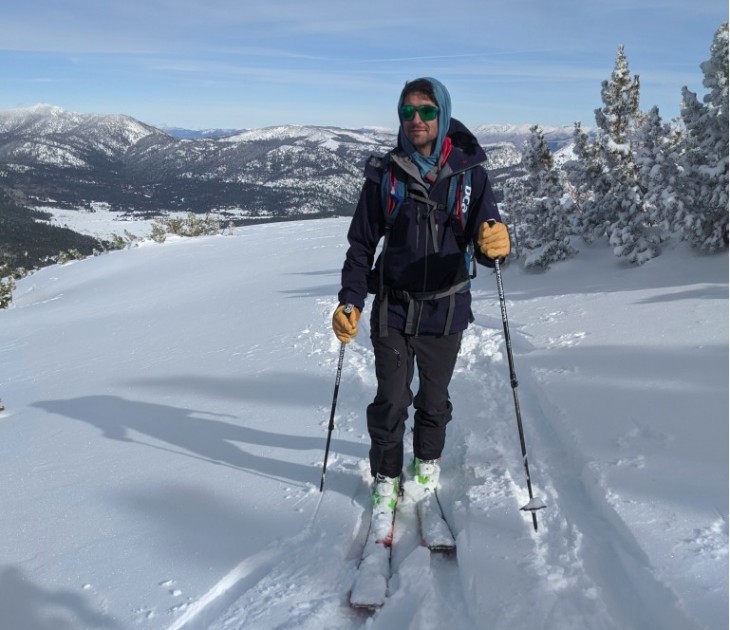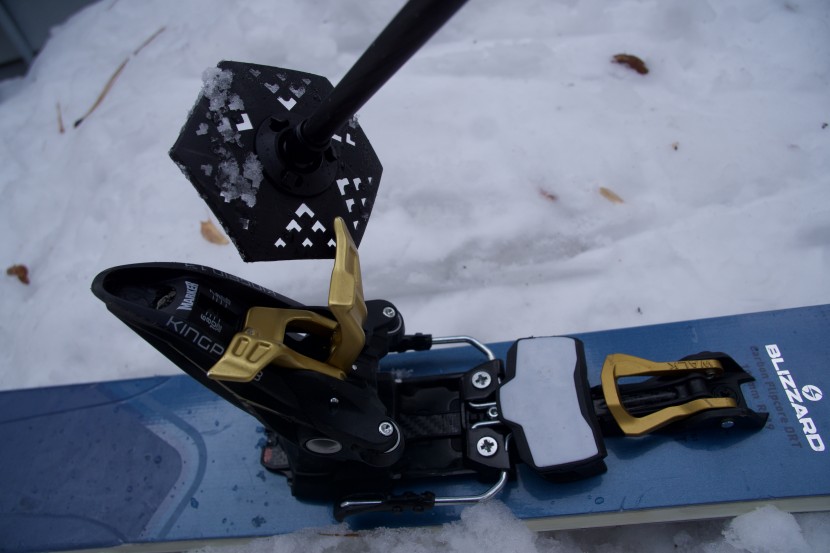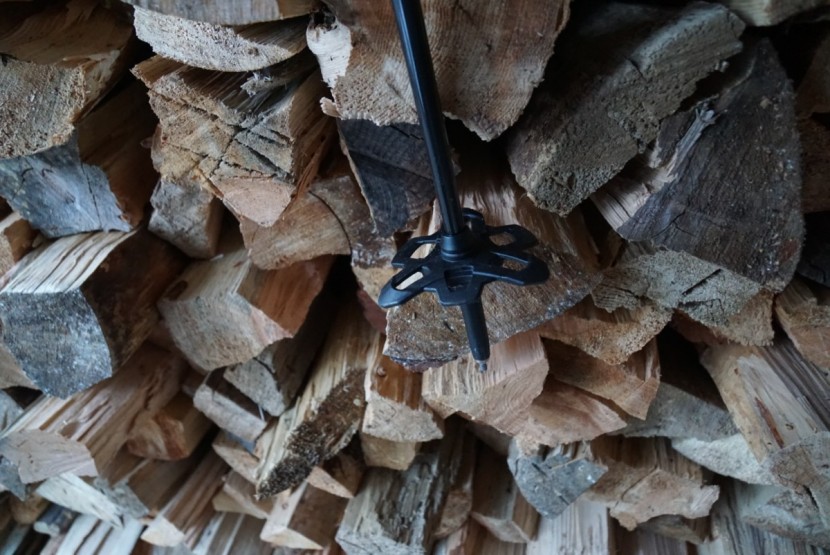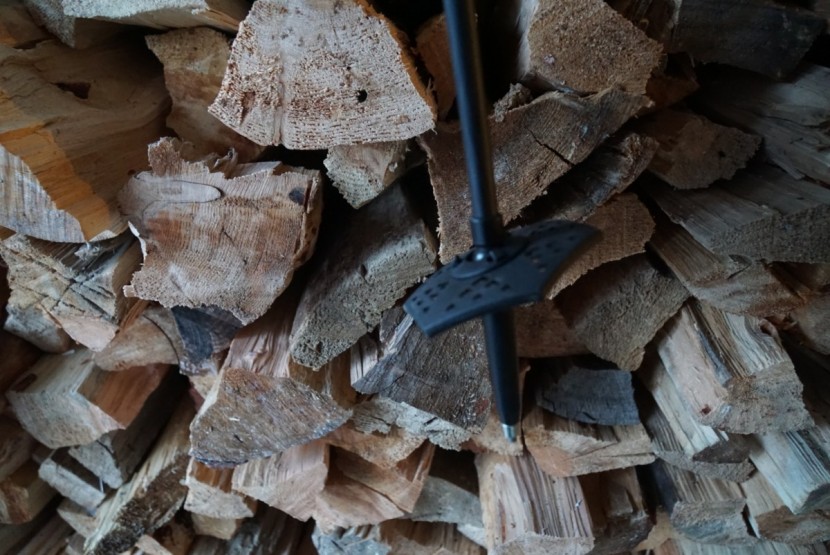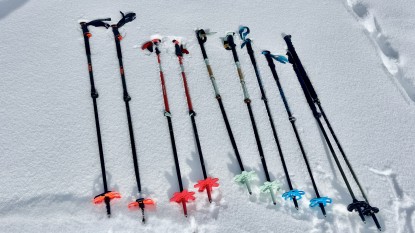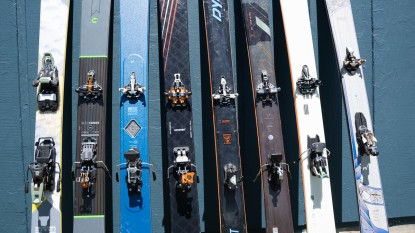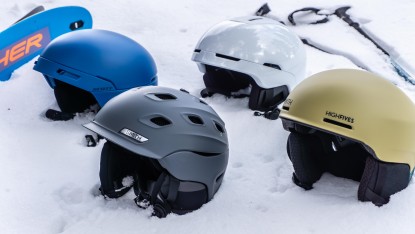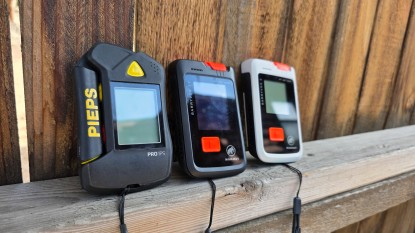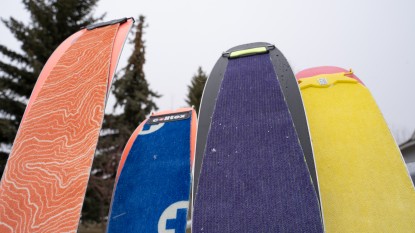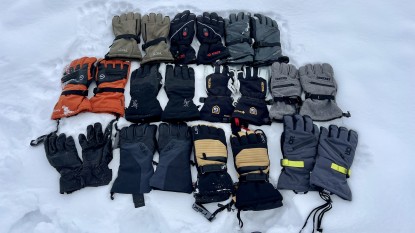Backcountry skiing requires a lot of gear. After carefully picking out your boots, bindings, skis, skins, backpack, transceiver, shovel, probe, and clothing, poles are probably the last thing you want to think about. Luckily, we have you covered. Our in-depth advice makes it easy to choose the best backcountry ski pole to meet your needs.
Key Differences from Inbounds Poles
Most backcountry skiers have prior experience skiing inside the boundaries of the ski area. Usually, they are advanced or expert skiers who own their equipment, and when first experiencing backcountry skiing, they often presume that they can use their resort poles in the backcountry. To some degree, that's true. The only thing that is absolutely mandatory in a backcountry ski pole is a powder basket, which many resort poles don't have. Without a powder basket, a pole tip will plunge deeply into the snow when used for leverage while skinning, and it won't provide any resistance. This renders the pole useless, making the ascent much more arduous. Other than that, skiers can probably get away with their resort poles, at least for a time.
Once skiers start to tour in the backcountry on a regular basis, we recommend picking up a pair of ski poles that will make life on the skin track much easier. These poles differ from their inbounds cousins in a few key design features, including adjustable lengths, secondary grips, specialty powder baskets, and lightweight constructions. We'll cover those below.
Poles for Splitboarders
If you are a snowboarder and are interesting in splitboarding, then you might be buying poles for the first time. Many splitboarders see poles as a skiers' tool and don't want to spend too much time associating themselves with the two-plank population. However, ensuring you have the right pole for backcountry splitboarding is even more important than it is for skiers. Splitboarding poles need to be effective and comfortable for the skin up, and then disassemble quickly and stash either onto or into a backpack for the descent. Resort ski poles won't work for splitboarders because they need to compress into a small size for the downhill portion of travel. Even first-time splitboarders are encouraged to buy, rent, or borrow a set of foldable or collapsible ski poles that will fit inside or attach cleanly on the outside of a backpack.
Different Types of Poles for Different Users
The first step in selecting the right pole for you is to determine for which activities the poles will be used. If you are only going to be using the pole for backcountry skiing, you'll select a different pole than if you will be both backcountry skiing and splitboarding. If you want to use the pole as a trekking pole in the summer, that will lead you to a different pole design.
Two-Section Poles
Most backcountry skiers prefer two-section telescoping poles. These are poles that feature an adjustable shaft that slides in and out, being held in place by a locking lever once the desired length has been chosen. Two-section telescoping poles are sturdy, light, and quick to adjust. The downside to this type of pole is that they usually don't collapse to a small minimum size, meaning you won't be able to strap them to the outside of a pack cleanly. This renders two-section poles useless for splitboarders and some trekking applications in the summer.
Three-Section Poles
Some companies make three-section telescoping poles for winter use. These poles have three shaft sections and two locking levers, allowing for smaller shaft sections and, ultimately, a smaller collapsed size. These poles are easier to stow on the outside of a backpack than two-section telescoping poles but still tend to stick out a little bit. These poles are best for backcountry skiers and splitboarders who need a durable, sturdy pole for use during both the winter season and the summer hiking and trekking season. Because they feature more moving parts and shorter shaft sections, these poles tend to be heavier and weaker than their two-section counterparts, but not by much.
Foldable Poles
Folding, or z-style poles, feature shaft sections that are connected in-line by a small cord that runs through the inside of each section. They also have tapered ends that fit together, so when the cord is pulled tight, the sections fit snugly together, similar to an avalanche probe or tent poles. When the cord is released, the shaft sections fold apart and can be stored side-by-side. This allows the user to strap the poles onto the outside of a backpack without any pole sticking out of the top or bottom of the pack. Alternatively, these poles can be stored inside the pack for the ultimate in aesthetic cleanliness. They usually fit inside day packs down to about 20 liters. The locking mechanism is usually fairly simple. In most cases, a spring-loaded button automatically snaps into place when the pole is extended, which simply needs to be pushed in to collapse the pole. Look for a simple locking mechanism to save time at transitions.
In general, z-poles are weaker than telescoping poles because the sections overlap by only a small amount of material and because the sections usually aren't held together as tightly. Foldable poles are great for splitboarders who want to stow their poles for each descent. Skiers generally need a stronger pole because foldable poles might not hold up to pole plants (when skiing downhill) over the lifetime of the product. Foldable poles are also great for trekking use and technical approaches in the summer.
Pole Material
Once you've chosen a pole design, your next step is deciding between a carbon pole and an aluminum pole. Pole material is an important component in a pole's durability and weight.
Aluminum
Most ski resort poles are made of aluminum because they bend instead of snapping, and they dent instead of chipping. Ski poles take a beating, and almost every skier has a memory of taking a bad fall and ending up with a bent pole. Aluminum poles last multiple seasons and will probably get lost before they break. The downside to aluminum is its weight. Aluminum poles are generally heavier than carbon poles, usually by an ounce or two per pair. We recommend aluminum poles to most backcountry skiers because they will last much longer than carbon poles, and the weight savings are almost negligible. Also, aluminum poles are much less expensive than carbon poles.
Carbon
The main upshot of carbon poles is their low weight. Ski mountaineers and backcountry skiers who log thousands of vertical feet want the lightest equipment out there, and carbon poles help shave an ounce or two from the total kit. They also save a few calories over the day by lightening each arm's load that has to swing the pole forward for each pole plant on the skin track. Carbon poles chip easily and need to be handled with care. As such, we generally point everyday backcountry skiers towards aluminum poles, and save the carbon poles for those who need the weight savings or who might invest in a separate set of carbon poles for their big days.
Hybrid
Many poles feature aluminum grip sections and carbon lower sections (where the powder basket lives). This allows for some weight savings while not compromising on strength in the upper section. This design also allows for a better swing weight, which is the effort it takes to swing a pole forward for the next pole plant. The more weight in the powder basket end of the pole, the more effort it will take to initiate a pole swing. Heavier swing weights can lead to sluggish performance, especially when you are trying to make tight, quick turns. Hybrid poles are useful for the majority of backcountry skiers, but we still think aluminum poles are worth considering for their durability. Hybrid poles routinely rank among the top performers in our comparisons because of their balance between weight and durability.
Grip Components
Once you've chosen which type of pole design to go with and what material pole you're looking for, consider the different grips available. You'll want to check out the primary grip shape and material, the secondary grip design, and the handle.
Primary Grip
Most ski poles have grips that are molded to fit the contours of your hand and feature rubber coatings that make them comfortable to hold with both gloved and bare hands. Each company has its own hand mold, and some are better than others. Look for a pole grip that is comfortable with your hand size, which is noted in each product's individual review. Some poles use foam in the grip to save weight, and foam is generally more comfortable than rubber on bare skin, but it is also more slippery to gloved hands. We prefer rubber grips on our ski poles for most uses, but if weight is a concern, or we are using the poles for summer hiking as well, foam grips are better.
Secondary Grip
Backcountry ski poles usually feature a secondary grip below the primary grip. This area is held by the uphill hand when skinning across the fall line of a slope so that the uphill hand isn't awkwardly high the whole time, and can provide leverage. Secondary grips are either a pad of material wrapped around the pole shaft, or a single ring of material that the thumb and forefinger can pull against while the rest of the fingers grip the pole shaft. Although it's the heaviest material this application, we like rubber wrap-around secondary grips because they provide the most friction, and we spend a significant portion of the day using this feature, so it has to be comfortable. Foam secondary grips are O.K., but we find ourselves dropping them a lot because foam has less friction than rubber. Secondary grips made from small rings of material are our least favorite because they provide the least friction and comfort. They do, however, weigh the least of the secondary grip designs.
Handle
Handle design is also an important factor in the use of a pole in the backcountry. Handle tops must be comfortable to push down upon because when the skin track gets steep, we end up pushing down on the top of our pole handles rather than down through our grip on the pole. Handles should also include some kind of hook in the area above the forefinger. This allows the pole to dangle off the forefinger when the user's grip is relaxed, preventing them from dropping the pole. We also like to use the hook feature for flicking heel risers up and down, and for locking tech toepieces after putting our skis back on.
Batons
Some poles of European origin are beginning to feature the “baton” design, where the handle, primary grip, and secondary grip are all cylindrical and uniform, often using foam as the grip material. Batons usually feature no contouring and no separation between the primary and secondary grip. Users can choke up on the pole at any time, usually in their uphill hand for steep skinning and in both hands for steep skiing. Also, choking down on the pole during downhill skiing allows the hand to act as a fulcrum, with the top of the pole being a counterweight to the bottom of the pole. This provides an effortless swing weight, as the pole becomes less of a lever and requires less energy to swing forward. Some skiers also choose to plant the handle end of baton-style ski poles when boot-packing up steep sections, providing a deeper, and therefore stronger, pole to help balance and gain leverage.
Typically, batons are lighter because their grips are made of foam, not rubber, and they don't have any molded plastic in the grip either. However, batons are less efficient for uphill travel because they don't allow for as much leverage due to the lack of a contoured grip or flat handle. Batons are best for downhill-oriented backcountry skiers or skiers hoping to look cool. Skiers who spend a lot of time on skin tracks will become frustrated by the lack of power transmission from the arms that batons provide. Batons are usually only available in fixed-length or telescoping poles.
Length
So far, we've narrowed down the design, materials, and grip design that you'll look for. Next, you'll decide how much length adjustability you need. For uphill skinning, your pole should reach from the ground to the height of your belly button. For downhill skiing, you'll want a shorter pole, about as high as your waist, and even shorter in deep powder or steep terrain. If you live in an area that has long approaches on flat roads or through forests, you'll want a pole that can extend to chest-height for Nordic-style double poling and skating. In general, seek a pole that has at least 20 centimeters (8 inches) of length adjustability.
Pole manufacturers often make poles in defined size ranges, so refer to the manufacturer's size charts when choosing. For example, this author is 6'2", and prefers poles at 125cm for uphill skinning, 110-115cm for downhill skiing, and 145cm for long, flat approach skating.
For splitboarding, length adjustability should be tailored to uphill skinning height, and potentially nordic height for long, flat approaches and skating. You won't need a pole length any shorter than waist height. Remember, they should also be collapsible down to about 16 inches for easy stowing on or in your backpack.
Powder Baskets
By this point, you should be well on your way toward deciding which pole is the best fit for your needs. It's worth taking a final look at powder baskets before you finalize your decision. All backcountry ski poles need powder baskets to help them push off soft snow. These are like snowshoes for your poles. Without them, your poles are useless, unless the surface is rock-hard. Powder baskets are just like normal pole baskets, except they have a large diameter, usually around three or four inches.
The same powder basket that provides floatation in soft snow can also prevent the tip from penetrating deeply in firm snow. When skinning uphill, we push our poles into the snow plumb with gravity to push vertically upwards against the pole. If the pole is placed vertically in a snow surface that is inclined, the pole basket will contact the snow surface on the uphill side. If the powder basket is too stiff, it will prevent the tip of the pole from penetrating the surface of the snow as deeply, leading to less stability and the potential for the pole tip to pop out of the snow.
Many poles feature soft, flexible powder baskets that allow the tip to penetrate firm snow surfaces more easily. Others feature asymmetrical powder baskets that are wide on one side, and small on another, like a hybrid of inbounds and backcountry baskets. Others are triangle-shaped, so if the point of the triangle contacts the snow on the uphill side, the whole basket spins to that a flat edge of the triangle, moving some of the basket material out of the way.
If you live and ski tour in an area where firm snow is the norm, a pivoting or asymmetrical powder basket is for you. If you live in an area where soft snow and powder skiing is the norm, then a rounded powder basket will be just fine. This feature isn't a deal-breaker but can make skinning on firm surfaces a breeze if you think you'll end up doing that a lot.
Ski Pole/Ice Axe Hybrids
Are you a steep skier or ski mountaineer? If so, you have probably encountered firm conditions in steep terrain. Both climbing up and skiing down firm, steep snow can be harrowing and insecure. To aid in those situations, and to eliminate the need to bring an ice axe on your objective, a few manufacturers produce poles that also feature ice picks to help increase purchase in firm snow. Most backcountry skiers won't need these products. Furthermore, ice axe technology is advancing to the point where a true, dedicated ice axe is of comparable weight to the pick attachment on these poles.
Conclusion
Follow our step-by-step selection method above, and you'll find the perfect pair of backcountry ski poles in no time. It can be a daunting journey for a piece of gear that seems so trivial, but the more you ski or ride in the backcountry, the more you'll appreciate a good set of sticks. So dig in, be picky, and you'll thank yourself later.

